
Ants are eusocial insects of the family Formicidae and, along with the related wasps and bees, belong to the order Hymenoptera. Ants evolved from vespoid wasp ancestors in the Cretaceous period. More than 13,800 of an estimated total of 22,000 species have been classified. They are easily identified by their geniculate (elbowed) antennae and the distinctive node-like structure that forms their slender waists.
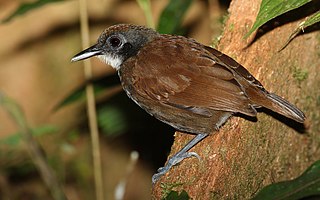
The antbirds are a large passerine bird family, Thamnophilidae, found across subtropical and tropical Central and South America, from Mexico to Argentina. There are more than 230 species, known variously as antshrikes, antwrens, antvireos, fire-eyes, bare-eyes and bushbirds. They are related to the antthrushes and antpittas, the tapaculos, the gnateaters and the ovenbirds. Despite some species' common names, this family is not closely related to the wrens, vireos or shrikes.

The plain-brown woodcreeper, is a sub-oscine passerine bird which breeds in the tropical New World from Honduras through South America to northern Argentina, and in Trinidad and Tobago. Sometimes it is considered to include the plain-winged woodcreeper as a subspecies.

A bivouac is a structure formed by migratory driver ant and army ant colonies, such as the species Eciton burchellii. A nest is constructed out of the living ant workers' own bodies to protect the queen and larvae, and is later deconstructed as the ants move on.

The name army ant (or legionary ant or marabunta) is applied to over 200 ant species in different lineages. Because of their aggressive predatory foraging groups, known as "raids", a huge number of ants forage simultaneously over a limited area.

The flame-colored tanager, formerly known as the stripe-backed tanager, is a medium-sized American songbird in the family Cardinalidae, the cardinals or cardinal grosbeaks. It is found from Mexico throughout Central America to northern Panama and occasionally in the United States; four subspecies are recognized. The flame-colored tanager is 18 to 19 cm long, the male having predominantly red-orange while the female is more yellowish orange.

Ant mimicry or myrmecomorphy is mimicry of ants by other organisms. Ants are abundant all over the world, and potential predators that rely on vision to identify their prey, such as birds and wasps, normally avoid them, because they are either unpalatable or aggressive. Spiders are the most common ant mimics. Additionally, some arthropods mimic ants to escape predation, while others mimic ants anatomically and behaviourally to hunt ants in aggressive mimicry. Ant mimicry has existed almost as long as ants themselves; the earliest ant mimics in the fossil record appear in the mid Cretaceous alongside the earliest ants. Indeed one of the earliest, Burmomyrma, was initially classified as an ant.

Eciton burchellii is a species of New World army ant in the genus Eciton. This species performs expansive, organized swarm raids that give it the informal name, Eciton army ant. This species displays a high degree of worker polymorphism. Sterile workers are of four discrete size-castes: minors, medias, porters (sub-majors), and soldiers (majors). Soldiers have much larger heads and specialized mandibles for defense. In lieu of underground excavated nests, colonies of E. burchellii form temporary living nests known as bivouacs, which are composed of hanging live worker bodies and which can be disassembled and relocated during colony emigrations. Eciton burchellii colonies cycle between stationary phases and nomadic phases when the colony emigrates nightly. These alternating phases of emigration frequency are governed by coinciding brood developmental stages. Group foraging efforts known as "raids" are maintained by the use of pheromones, can be 200 metres (660 ft) long, and employ up to 200,000 ants. Workers are also adept at making living structures out of their own bodies to improve efficiency of moving as a group across the forest floor while foraging or emigrating. Workers can fill "potholes" in the foraging trail with their own bodies, and can also form living bridges. Numerous antbirds prey on the Eciton burchellii by using their raids as a source of food. In terms of geographical distribution, this species is found in the Amazon jungle and Central America.
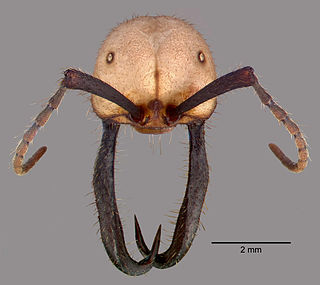
Ecitoninae is an ant subfamily.

Eciton is a New World army ant genus that contains the most familiar species of army ants. The most predominant and well-known species is Eciton burchellii, which is also more commonly known as the army ant and is considered the type species.
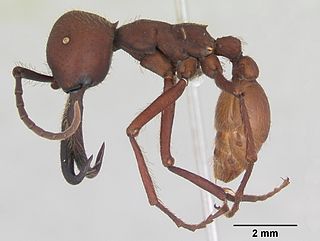
Eciton vagans is a species of New World army ant in the genus Eciton. It occurs in dry and wet forest habitats, occupying a range extending from Mexico to throughout Costa Rica and possibly Panama and Colombia. Raids are always in columns and are distinguished in being usually nocturnal; preferred prey commonly include other ants. It is closely related to the Eciton burchellii species.
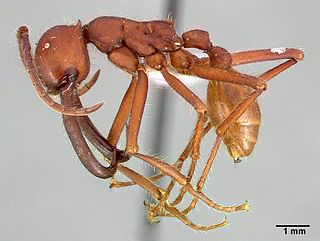
Eciton mexicanum is a species of New World army ant in the genus Eciton. Present from Mexico to throughout Costa Rica and northern Argentina, it is found in dry and wet forests in sea level to montane areas. Raids always occur in columns, tending to be usually nocturnal but are sometimes also encountered during the day. It is closely related to the Eciton burchellii species.

The black-and-white antbird is a species of bird in the family Thamnophilidae. It is monotypic within the genus Myrmochanes. It is found in Bolivia, Brazil, Colombia, Ecuador, and Peru. Its natural habitats are subtropical or tropical moist lowland forests and subtropical or tropical moist shrubland.

The ocellated antbird is a species of antbird in the family Thamnophilidae. It is monotypic within the genus Phaenostictus and is found in southern Central America and the northwestern part of South America. Its natural habitat is the understory of tropical moist lowland forest, foothill forest, and tall secondary growth woodlands.

The plain-winged woodcreeper or thrush-like woodcreeper is a passerine bird belonging to the woodcreeper group, now classified in the ovenbird family, Furnariidae. It is sometimes considered to be a subspecies of the plain-brown woodcreeper

Myrmecophagy is a feeding behavior defined by the consumption of termites or ants, particularly as pertaining to those animal species whose diets are largely or exclusively composed of said insect types. Literally, myrmecophagy means "ant eating" rather than "termite eating". The two habits often overlap, as both of these eusocial insect types often live in large, densely populated nests requiring similar adaptations in the animal species that exploit them.
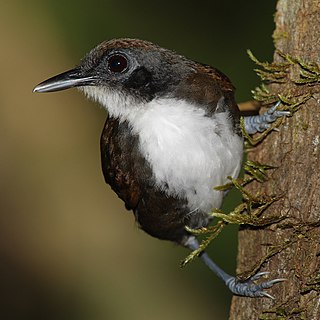
Ant followers are birds that feed by following swarms of army ants and take prey flushed by those ants. The best-known ant-followers are 18 species of antbird in the family Thamnophilidae, but other families of birds may follow ants, including thrushes, chats, ant-tanagers, cuckoos, motmots, and woodcreepers.

Carebara diversa, is a species of marauder ant widely distributed throughout Asia.
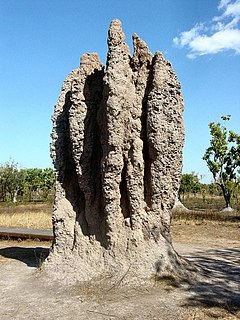
Structures built by animals, often called animal architecture, abound in nature. Examples of animal structures include termite mounds, wasp and beehives, burrow complexes of rodents, beaver dams, elaborate nests of birds, and webs of spiders.

Carl W. Rettenmeyer was an American biologist who specialised in army ants. He was born in Meriden, Connecticut and later attended Swarthmore College in Pennsylvania. He first became interested in army ants when he visited Panama as an undergraduate and then returned there as a postgraduate. Although he studied many aspects of army ant biology, he particularly focused on the animals associated with the ants and especially mites which live on the ants. He was well known for his photography of army ants, with his photographs appearing in over 100 publications and he used his video footage to create two DVDs. He taught at the University of Kansas from 1960 until 1971 and then at the University of Connecticut until his retirement in 1996, after being diagnosed with Waldenstrom’s macroglobulinemia. After his death in 2009, a set of papers on army ants were published in Insectes Sociaux in memory of his work.




















